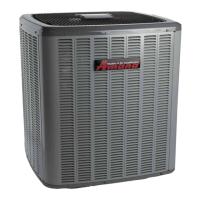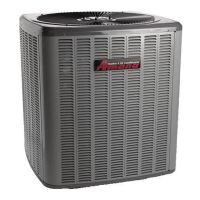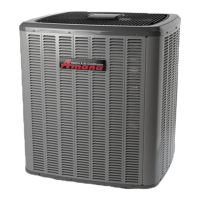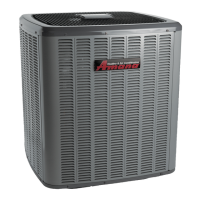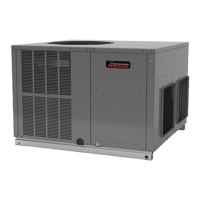SYSTEM OPERATION
23
SEQUENCE OF OPERATION
AVPTC/DSXC Condenser
The AVPTC air handler matched with an ASXC or GSXC
condensing unit constitutes a communicating network. The
two components, or subsystems, making up the system
communicate with one another with information passed
between both components.
The thermostat sends a 24VAC Y signal to the control
requesting cooling. The internal control algorithms will then
send a request for low stage cooling through the network to
the unitary (UC) control in the condenser. The UC control
receives the command and processes any compressor and
fan delays.
The UC control sends a request for low stage fan
speed to the air handler/modular blower. The blower
energizes the ECM blower motor at the appropriate speed.
The condenser energizes the compressor and
condenser fan motor at the appropriate low stage speeds.
The system operates at low stage cooling.
If the thermostat demand cannot be met on low stage
cooling, the internal algorithm of the board takes over and
sends a request for high stage cooling to the condenser.
The condenser in turn sends a request for high stage
fan speed to the air handler/modular blower. The blower
increases the blower speed to the high stage cooling
speed.
The condenser’s unitary control energizes the high
stage compressor solenoid and switches the condenser
fan motor to high speed.
The system operates at high stage cooling.
Once the thermostat demand is satised, the
thermostat commands the UC control to end cooling
operation. The condenser de-energizes the compressor
and condenser fan motor. The UC control continues
providing a fan request until any cooling blower OFF delays
have expired.
The thermostat sends a request for emergency heat to
the air handler.
The air handler control energizes the ECM blower
motor at the emergency heat speed. The electric heat
sequencer outputs are also energized, thus energizing the
electric heaters.
The system operates at emergency heat.
Once the thermostat demand is satised, the
thermostat commands the air handler to end emergency
heat operation. The air handler control de-energizes the
electric heat sequencer outputs. The ECM blower motor
remains energized until any blower OFF delay timing has
expired.
With a demand for continuous fan operation, the
thermostat sends a fan request (24VAC G signal) to the
integrated air handler. The control energizes the variavble
speed ECM motor at fan demand based on the menu
setting. The fan demand provided by the thermostat
will range between 30% and 100% of the air handler’s
maximum airow capability.
If the thermostat demand for continuous fan is
removed, the integrated AH control immediately de-
energizes the ECM blower motor.
AVPTC/DSZC Heat Pump and CTK0*
Communicating Thermostat
The AVPTC matched with an ASZC or DSZC condensing
unit wired in 1 and 2 between the indoor and outdoor
constitute a communicating system. The three
components, or subsystems, making up the system
communicate with one another with information passed
between the two components. This leads to a somewhat
non-traditional manner in which the system components
receive commands for system operation. All system
commands are routed from the component through the
network to the appropriate destination component.
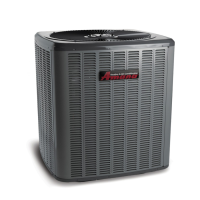
